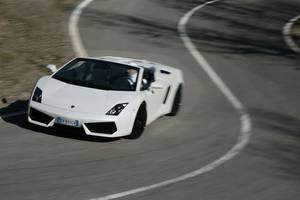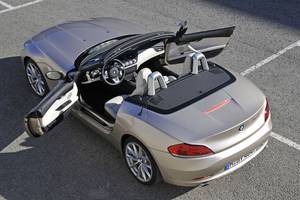back
DTE news - Lamborghini Gallardo LP 560-4 Spyder - BMW Z4 sDrive 35i - 30 years of the Mercedes G-Class - Comparison test Mazda CX-7 / Mercedes GLK 320 CDI

Drive report: Lamborghini Gallardo LP 560-4 Spyder
Wild facts
This car belongs to the hills north of Los Angeles. The sun is going down, the road is winding and the sound system doesn't stand a chance against the 560 hp in the back. A ride in the open-topped Lamborghini Gallardo is an unforgettable experience.
The car is not new; nor is the sun worshipper: yet the Gallardo LP 560-4 Spyder has audibly more power and a new sportiness which, even in the light Superleggera model, pleased this driver no end. When it comes to driving performance, a sports car with 560 hp and terrific mileage is made for the German autobahns, maybe even the foothills of the Alps. Or, if showing off is your aim, you might want to take a slow cruise along Miami's Ocean Drive, a night-time drive through the Florida Keys or a hot ride through the chain of hills found north of Los Angeles. Whether you're driving in Germany and America, the latest man toy from Lamborghini is pure automobile Viagra for all those who have driven everything else before.
560 hp, maximum speed of 324km/h and 0 to 100km/h in just four seconds It's not that the previous Gallardo roadster with its potent ten-cylinder engine would have made a poor impression. Far from it. But the power injection that has just benefited the closed version comes at just the right time for the open-topped Spyder. "With the Spyder, we have a car that adds nothing less than a whole new dimension to the new Gallardo range. It is an entirely new car, based on the technology and design of the Gallardo LP 560-4", explains Lamborghini CEO Stephan Winkelmann, presenting the latest trinket of north Italian automobile art. "The new Gallardo LP 560-4 Spyder is quite simply a breathtaking car and, in its extreme consequence, quite without competition."

Drive report: BMW Z4 sDrive35i
Evokes feeling of springtime
In the roadster segment, the Z4 always played second fiddle to the more successful SLK. That could be about to change: with greater comfort and suitability for everyday use, as well as a superb suspension, the new Z4 has become a real star chaser.
"The roadster means pure emotion. Even in difficult times, this is the case", believes Klaus Borgmann. With the new Z4, we wanted to retain our old customers and attract some new ones" says the man in charge of the 1, 3, X3 and Z4 Series. With the new Z4, BMW is mainly targeting customers who have high standards in terms of comfort.
More comfortable and fit for everyday use than its predecessor
The Z4 is less puristic and hard than before, making it all the more comfortable and suitable for everyday driving. By fully utilising the adjustment options available for the steering wheel, even larger drivers should be able to find the perfect position for them behind the wheel. Thanks to an electronic parking brake, there is space for a centre console with a small stowage compartment and cup holders while behind the seats, some small items may be stowed away in the luggage nets.
The wide hatch in the boot allows you to take two pairs of skis or other bulky belongings with you wherever you are going. With closed top, the boot has a capacity of 310 litres (Mercedes SLK: 300 litres, VW Eos: 380 litres, Audi TT Roadster: 250 litres). If you want to drive with the top down, there is enough space left over for 180 litres of luggage, which can be stowed under a plastic cover. Under the floor of the boot meanwhile, you will find the car's battery – it makes itself at home in the rear of the car, to the benefit of better weight distribution.

A time to celebrate: 30 years of the G-Model
An all-terrain legend
The federal government call it "The Wolf", the Pope uses it when greeting his mass audiences and it faces difficult terrain as nonchalantly as Siegfried faced the monster. A look back at 30 years of the G-Model.
When children paint pictures of cars, this is how they often look: a small square for the front part, a large one for the passenger cabin and then the wheels underneath. Add on two indicators to the hood and you pretty much have the Mercedes G-Model. The Mercedes climber has been put through its paces in the fields, forests, meadows and boulevards of this world since 1979. Under the tin, a lot has changed since then; yet in terms of its appearance, the Trabant has had more facelifts than the G-Model.
It all started in the 1970s
In the 70s, the majority of all-terrain vehicles were driven by those working in forestry, construction or in the armed forces. The Jeep Wagoneer and the Range Rover were among the few competitors of the first G-Model. With the release of the Range Rover Vogue in 1970, the British appealed to the notion of lifestyle plus camp-fire romanticism. Three years later, Daimler-Benz and Steyr-Daimler-Puch began work in the Austrian city of Graz on the development of an all-terrain vehicle bearing the famous Mercedes star. The Austrians were able to incorporate the offroad know-how they gained with cars like the famous "Pinzgauer".

Comparison test: Mazda CX-7 – Mercedes GLK 320 CDI
Round and sporty vs. angular and robust
The Mercedes and Mazda brands could hardly be more different. Yet, in the market segment of mid-range four wheel drive vehicles, they are constantly fighting each other for supremacy, the round, sporty Mazda CX-7 battling the angular, robust Mercedes GLK.
As everyone knows, seeing something for yourself is worth more than a thousand words. Visually, the Mercedes GLK and the Mazda CX-7 have just as much in common as a glimpse at the various model ranges of their manufacturers would suggest.
The Mazda CX-7 underscores its sporty aspirations with its emphatically dynamic exterior. Were it not for its height, it could just as easily be a powerful saloon, a sports tourer or even a coupé. The Mercedes GLK came into being quite late – in light of the excellent sales figures for the BMW X3, far too late. This placed the designers under all the more pressure to give the straggler its own independent, special look. With its edges and unusually sharp lines, it differs not only from the CX-7 but also from all its other competitors which, over the past two years, have begun to take on a much softer appearance. "Our customers do not want a soft-roader", emphasises Mercedes Developer Thomas Ruhl, commenting on the GLK.
Conclusion
The Mazda CX-7 is clearly the better value of the two vehicles – despite the high fuel consumption and the higher depreciation in value that can be expected. The almost fully equipped Mazda CX-7 Expression, featuring electric leather seats, xenon lights, ESP and lots of other comforts, costs a fair-enough EUR 35,400. In the United States, the same car can be bought with DVD navigation and reversing camera for the equivalent of EUR 10,000 less. For that reason, a trip to the American importer of the cars may be worth while – at least until the diesel version appears in the autumn. With considerably poorer comfort features, the GLK 320 CDI will set you back at least EUR 46,053. With nearly identical features, it costs over EUR 10,000 more. On balance, the Mercedes GLK 320 CDI is not only the car with more corners and edges, it also represents the better overall package. That said, the price and the high-revving four-cylinder engine do make the Mazda CX-7 a more than interesting alternative.
back



